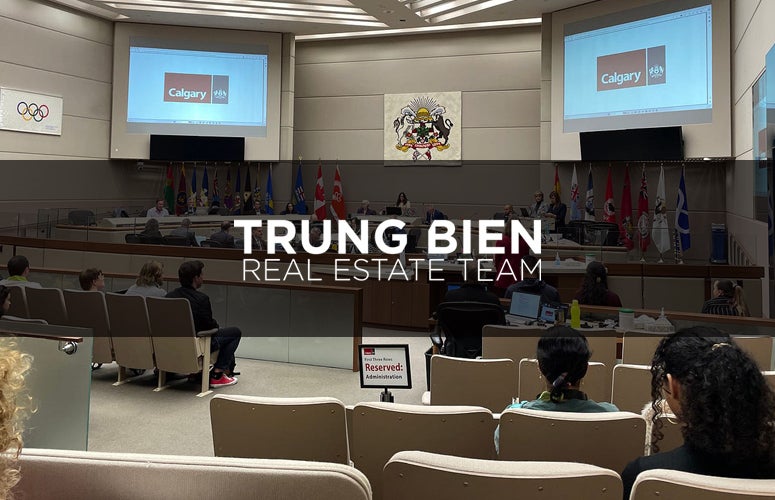Rifts over rezoning continue as the City Council’s public hearing unfolds.
Separate rallies have been held outside city hall as a marathon public hearing on Calgary City Council’s proposed blanket rezoning, expected to last a week or longer, is now underway.
Though only one aspect of the city’s housing strategy, blanket rezoning is undoubtedly the most contentious and emotional. "Dozens of people lined up inside the municipal building atrium Monday morning, hoping to register last minute for a five-minute time slot to share their thoughts with the council,” in what Council anticipates will be its longest-ever public hearing.1
While blanket rezoning has emerged as a divisive issue which seems to pit so-called NIMBY (not in my backyard) homeowners against renters, migrants and other Calgarians who don’t have access to affordable housing, in reality, the issue is more nuanced.
In fact, much of what’s really at stake is a broader discussion about who should decide how neighbourhoods should look in the future in a city undergoing unprecedented historical transformation.
Before deciding where you stand, here are a few things to consider.
1 https://calgaryherald.com/news/local-news/blanket-rezoning-marathon-public-hearing-kicks-off
Why remove the red tape?
As a real estate agent and a homeowner in Calgary’s Inglewood neighbourhood, I’ve generally been in favour of inner-city development that favours the kind of mixed-use housing supported by the RC-G blanket rezoning proposal which permits building single-detached, semi-detached, suites and rowhouses on any low-density residential property.
One of the arguments here is that the city already approves the vast majority of rezoning applications. So, for over 95% of proposed development projects, current zoning processes add unnecessary time and cost. Eliminating the red tape allows developers to build homes faster and meet demand with homes that typically cost less than single-family residences.
In addition to opening up opportunities for buyers who can’t afford a single-family home to be a part of the community, densification and mixed-use housing can enliven and revitalize communities, bolster local businesses, make neighbourhoods more vibrant and amenity-rich, and attract money and investment.
For example, many Calgarians now know Inglewood as a lively and upscale neighbourhood perfect for strolling around on a Saturday or Sunday afternoon. Believe it or not, in the 1960s, most of Inglewood was considered an undesirable neighbourhood with a declining population and the perfect site for a freeway. 2
2 https://www.sprawlcalgary.com/blanket-rezoning-inglewood?mc_cid=14ce042fd5&mc_eid=78ee9ec909
There’s more to it than nimbyism
Of course, the story is not that simple, and development is not always the be-all and end-all solution, especially when it comes to affordable housing.
In many instances, inner-city development can drive home prices up by making those areas more desirable. This was definitely the case in Inglewood where, with increasing gentrification, the neighbourhood became “increasingly unaffordable for many, including the working-class residents who made Inglewood what it was.” 3
What’s also unfortunate is that residents with legitimate concerns over the impact of densification and increased development on their neighbourhoods are often summarily dismissed as NIMBYs, a niche group concerned only about their self-interest.
Concerns voiced by residents in established communities most impacted by blanket rezoning are more far-reaching and community-orientated than they are generally branded. In the city’s What We Heard report released in mid-April approximately 70% of the feedback the city received expressed concern about rezoning, with 52 community associations having signed a letter to the city in opposition to the proposal.
In Bridgeland, for example, another neighbourhood with a similar story to Inglewood’s, residents have pointed out how densification has led to the removal of residential trees, increased wear-and-tear to public spaces, degradation of natural spaces, lack of sufficient parking, and increased traffic and congestion on residential streets, eroding many of the charming features these communities were built on.
3 https://www.sprawlcalgary.com/blanket-rezoning-inglewood?mc_cid=14ce042fd5&mc_eid=78ee9ec909
No winner takes all
What’s really at stake here is not just affordable housing but also who makes decisions that determine the fate of neighbourhoods and how they will look in the future. Are all relevant parties consulted as part of the process?
Should decisions about zoning or rezoning be made from the top down by experts, city officials and bureaucrats who must respond to more significant shifts in the city’s housing market?
Or should they be made from the bottom up by community stakeholders and residents who helped establish the very communities these top-down policies impact?
Framed in this lens, it becomes clear just how complex the issue really is, especially considering the unprecedented demand for housing.
It’s not just a matter of being for or against development or rezoning. Regarding the future of our city and the incredible neighbourhoods home to all Calgarians, there’s no clear resolution where everybody comes out an absolute winner. Ultimately, workable solutions will need to be a mix of both, taking into account the interests of all Calgarians and involving some mix of top-down and bottom-up approaches to policy.
This requires conversation, dialogue, and understanding the vested interests of all our city’s citizens. Hopefully, this week’s public hearings provide a good starting point.
Interested in learning more? Here’s a few great links:


